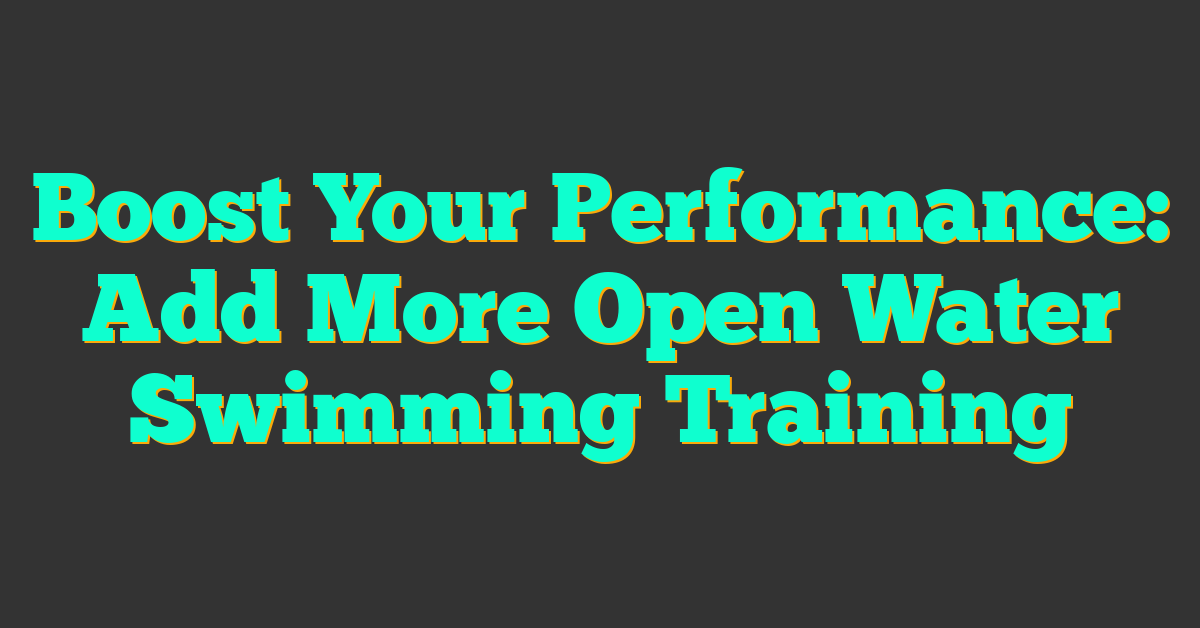If you’re looking for a new challenge to add to your swimming routine, open water swimming may be the perfect fit. Open water swimming offers a unique experience that can’t be replicated in a pool, with the added benefit of exploring new bodies of water. However, open water swimming requires a different set of skills and training than pool swimming. In this article, we’ll discuss how to get started with open water swimming, develop your skills, create a structured training plan, and ensure safety and confidence in open water.

The first step to getting started with open water swimming is to find a suitable body of water. This can be a lake, river, or ocean, but it’s important to research the location and ensure it’s safe for swimming. Once you’ve found a suitable location, it’s important to acclimate yourself to the water temperature and conditions. This can be done gradually by starting with shorter swims and gradually increasing the distance. It’s also important to have the right gear, including a wetsuit, goggles, and swim cap.
Developing your open water swimming skills is essential to ensure a safe and enjoyable experience. This includes sighting, navigation, and drafting techniques. Sighting involves lifting your head out of the water to look for landmarks or buoys to guide your swim. Navigation involves using these landmarks to navigate your swim course. Drafting involves swimming closely behind another swimmer to conserve energy. By developing these skills, you’ll be able to swim more efficiently and confidently in open water.
Key Takeaways
- Open water swimming requires different skills and training than pool swimming.
- To get started, find a suitable body of water and acclimate yourself to the conditions.
- Developing your open water swimming skills is essential for a safe and enjoyable experience.
Getting Started with Open Water Swimming
https://www.youtube.com/watch?v=57is_2acXs4&embed=true

If you’re new to open water swimming, it can be a bit daunting to get started. However, with the right gear and some basic knowledge, you’ll be able to enjoy the freedom and excitement that comes with swimming in open water. In this section, we’ll cover the basics of getting started with open water swimming.
Understanding Open Water vs Pool Swimming
The first thing you need to understand is that open water swimming is very different from pool swimming. In a pool, you have clear, calm water with clear lane markers and a smooth bottom. In open water, you have to deal with waves, currents, and changing water conditions. You also don’t have the convenience of a wall to push off from every few seconds.
To get started with open water swimming, it’s important to practice in a pool first. This will help you get comfortable with the basic swimming techniques and build your endurance. Once you feel confident in the pool, you can start to transition to open water.
Essential Gear for Open Water Swim Training
To get started with open water swimming, you’ll need some basic gear. Here’s a list of the essential gear you’ll need:
- Wetsuit: A wetsuit is essential for open water swimming. It will keep you warm and buoyant in the water. When choosing a wetsuit, make sure it fits snugly but isn’t too tight.
- Goggles: Goggles are important for open water swimming because they protect your eyes from the sun, wind, and waves. Make sure you choose a pair that fits comfortably and doesn’t leak.
- Swim Cap: A swim cap will keep your hair out of your face and help you stay visible in the water. Choose a brightly colored cap for maximum visibility.
- Sunscreen: Even if it’s cloudy outside, you can still get sunburned while swimming. Make sure you apply sunscreen before you start swimming to protect your skin from the sun’s harmful rays.
In addition to these essentials, you may also want to consider getting a swim buoy, which will help you stay visible in the water and provide a place to rest if you need it. With these basics in hand, you’ll be ready to start exploring the open water and enjoying all the benefits of this exciting sport.
Developing Your Open Water Skills
https://www.youtube.com/watch?v=SKKzhclB0Jk&embed=true
Open water swimming is a unique experience that requires a different set of skills compared to swimming in a pool. To become a proficient open water swimmer, you need to develop specific skills. In this section, we will discuss some of the essential skills you need to master to become a successful open water swimmer.
Mastering Sighting Techniques
Sighting is an essential skill in open water swimming that helps you swim straight towards your destination. To sight correctly, you need to lift your head out of the water and look forward to see where you are going. However, sighting can be challenging, especially if you are not used to it. To master sighting, you should practice it regularly in the pool and open water. You can also use landmarks to guide you while swimming.
Breathing and Stroke Adjustments
Breathing and stroke adjustments are crucial in open water swimming. In open water, you may encounter waves, currents, and other obstacles that can affect your breathing and stroke. To overcome these challenges, you need to adjust your breathing and stroke accordingly. For example, you can take shorter breaths or switch to bilateral breathing to adapt to the changing conditions.
Navigating Through Waves and Currents
Navigating through waves and currents is another essential skill in open water swimming. In open water, you may encounter waves and currents that can push you off course or slow you down. To navigate through waves and currents, you need to learn how to swim with the waves and currents instead of fighting against them. You can also use treading water and swimming with a partner to help you navigate through challenging conditions.
In conclusion, developing your open water skills is crucial if you want to become a successful open water swimmer. By mastering sighting techniques, adjusting your breathing and stroke, and navigating through waves and currents, you can improve your open water swimming skills and become a more confident and competent swimmer.
Creating a Structured Training Plan
https://www.youtube.com/watch?v=q71tbUqifzo&embed=true
If you want to improve your open water swimming skills, you need to create a structured training plan that incorporates drills, speed work, and endurance building. A well-structured plan will help you stay motivated, track your progress, and prepare you for race day.
Incorporating Drills and Speed Work
Incorporating drills into your training sessions can help you improve your technique and efficiency in the water. Drills such as catch-up, sculling, and finger-tip drag can help you focus on specific aspects of your stroke and improve your overall swimming ability. Additionally, adding speed work to your training plan can help you increase your pace and build endurance. Incorporating interval training, sprints, and pace work into your workouts can help you get faster and more efficient in the water.
Building Endurance for Race Day
Building endurance is crucial for open water swimming. Your training plan should include a variety of workouts that focus on building your endurance for race day. Long, slow distance swims, threshold sets, and continuous pool swims are all great ways to build endurance and prepare for the demands of open water swimming. Additionally, incorporating open water swims into your training plan can help you get used to the conditions and challenges of swimming in open water.
To create a structured training plan that works for you, consider working with a coach or using a training program designed specifically for open water swimmers. This can help you stay on track, monitor your progress, and make adjustments to your plan as needed. Remember to be consistent with your training sessions, stay motivated, and focus on building your endurance, technique, and speed. With a well-structured plan and consistent training, you can improve your open water swimming skills and prepare yourself for race day.
Safety and Confidence in Open Water
https://www.youtube.com/watch?v=UA0pFOVgwfE&embed=true
Open water swimming can be a fun and exhilarating experience, but it’s important to prioritize safety and confidence in the water. Here are some tips to help you acclimate to cold water, use safety devices, and swim with a partner.
Acclimating to Cold Water
« 9 vs 10 vs 11 Speed Bike Cassettes Cost: Which One Is the Best Value?
Aero Helmets: The Key to Faster Cycling Performance »
Swimming in cold water can be challenging, but it’s important to acclimate your body to the temperature before diving in. Start by gradually decreasing the temperature of your showers and baths, and try swimming in progressively colder water to help your body adjust. Additionally, wearing a wetsuit can keep you warm and comfortable during your swim.
Using Safety Devices and Swimming with a Partner
To ensure your safety while swimming in open water, consider using a safe swimmer buoy. This device is attached to your waist and floats behind you, making it easy for boaters to spot you in the water. It also provides a convenient place to store your belongings while you swim.
Swimming with a partner is also a great way to stay safe in the water. Not only can you keep an eye on each other, but you can also motivate and encourage each other during your swim. Make sure to establish clear communication and set boundaries before getting in the water.
By acclimating to cold water, using safety devices, and swimming with a partner, you can enjoy a safe and confident open water swim. Remember to always prioritize safety and never swim alone.
Pre-Race Preparation and Recovery
https://www.youtube.com/watch?v=qFLfBqOuZrc&embed=true
Preparing for an open water swimming event requires more than just swimming practice. In fact, you need to pay attention to your pre-race preparation and post-race recovery to maximize your performance. Here are some tips to help you prepare for your next open water swimming event.
Tapering Before the Event
Tapering is an important part of your pre-race preparation that involves reducing your training load to allow your body to recover and prepare for the upcoming event. It is recommended that you start tapering your training two to three weeks before the event. During this period, reduce your training volume and intensity and focus more on technique and skill work.
Warm-Up and Cool Down Routines
A proper warm-up routine is essential to prepare your body for the race. Before the event, take at least 10-15 minutes to warm up your muscles and get your heart rate up. You can do some light jogging, stretching, and dynamic movements to get your body ready for the swim. After the race, take some time to cool down and stretch to help your body recover.
Nutrition and Hydration Strategies
Proper nutrition and hydration are key to your performance in open water swimming events. Make sure you eat a balanced diet that provides enough energy for your training and race day. On the day of the event, make sure you eat a light breakfast at least two hours before the start time. During the race, stay hydrated by drinking water or sports drinks regularly.
To sum up, preparing for an open water swimming event involves more than just swimming practice. You need to pay attention to your pre-race preparation and post-race recovery to maximize your performance. By following the tips above, you can ensure that you are ready to perform at your best on race day.
Frequently Asked Questions

What is a good training plan for a 1-mile open water swim?
Training for a 1-mile open water swim requires a combination of endurance, strength, and technique. Your training plan should include regular swimming sessions, both in the pool and open water. Aim to gradually increase the distance of your open water swims. Incorporate interval training and speed work to improve your overall pace. Additionally, focus on developing your breathing technique, sighting, and navigation skills.
How should I prepare for a 2-mile open water swim event?
Preparing for a 2-mile open water swim event requires a more rigorous training plan. You should aim to swim at least 3-4 times a week, with a combination of pool and open water sessions. Gradually increase the distance of your open water swims, and incorporate interval training and speed work to improve your endurance and pace. Focus on developing your breathing technique, sighting, and navigation skills. Additionally, consider incorporating strength training exercises to improve your overall fitness and prevent injury.
What strength training exercises are beneficial for open water swimmers?
Strength training exercises can help improve your overall fitness and prevent injury. Focus on exercises that target your core, back, shoulders, and legs. Examples include planks, pull-ups, push-ups, squats, lunges, and deadlifts. Additionally, consider incorporating exercises that target your hip flexors, as these muscles are crucial for efficient swimming technique.
How can I find open water swimming locations near me?
To find open water swimming locations near you, check with your local parks and recreation department, or search online for open water swimming groups or clubs in your area. Additionally, consider using apps or websites that provide information on open water swimming locations, such as Swimply, Openwaterpedia, or Swim Guide.
What are some effective open water workouts for a 750m swim?
Effective open water workouts for a 750m swim should focus on building endurance and improving your overall pace. Consider incorporating interval training, speed work, and longer distance swims into your training plan. Additionally, focus on developing your breathing technique, sighting, and navigation skills.
Can you share strategies to improve performance in open water swimming?
To improve your performance in open water swimming, focus on developing your overall fitness, technique, and mental toughness. Incorporate regular swimming sessions, both in the pool and open water. Gradually increase the distance of your open water swims, and incorporate interval training and speed work to improve your endurance and pace. Focus on developing your breathing technique, sighting, and navigation skills. Additionally, consider incorporating strength training exercises to improve your overall fitness and prevent injury. Finally, practice visualization and mental preparation techniques to improve your mental toughness and confidence in open water swimming events.










